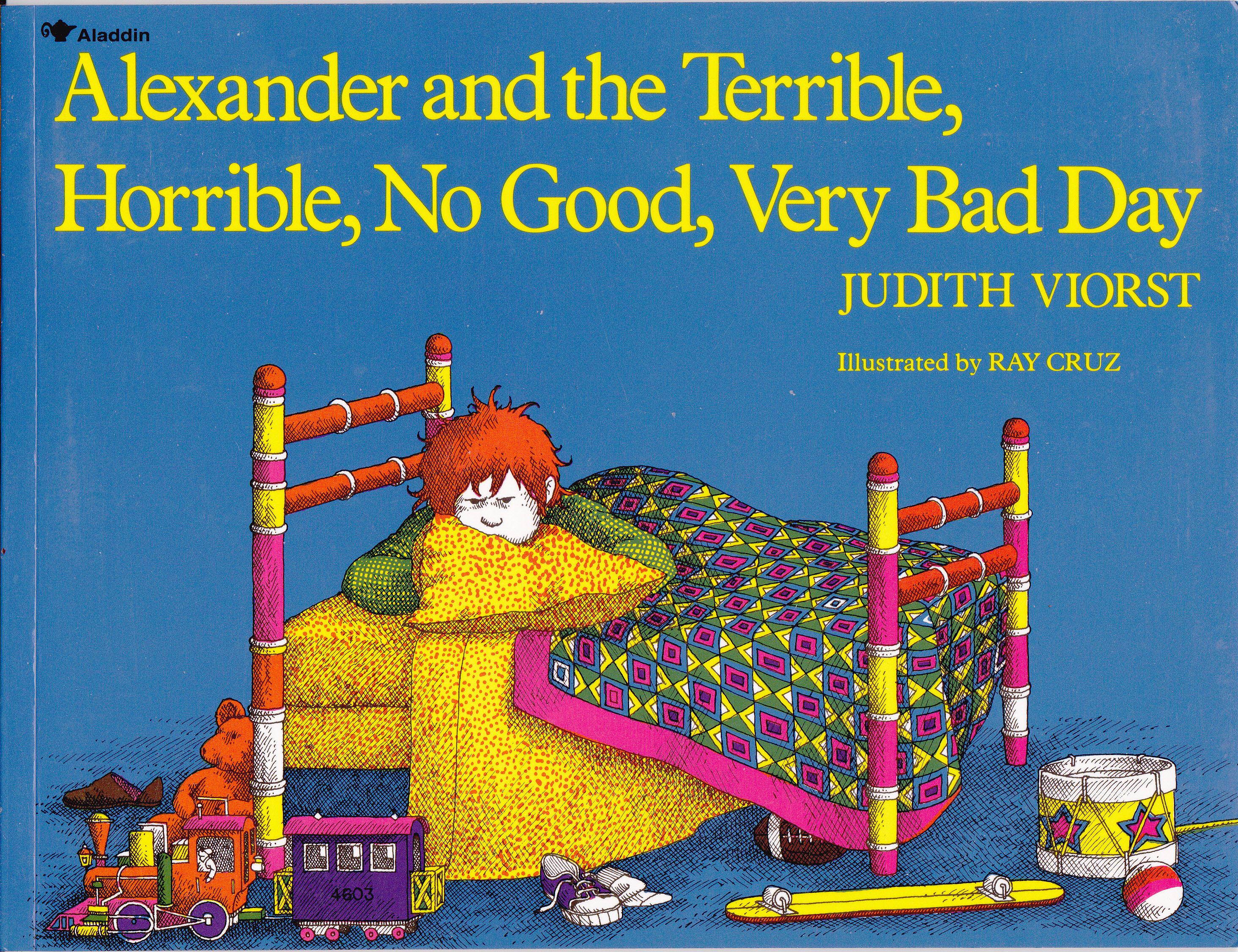Unto the multiplex this weekend creeps Alexander and the Terrible, Horrible, No Good, Very Bad Day, an adaptation of the Judith Viorst story published by Atheneum in 1972 and nominated by me right now as one of the worst children’s books I have ever read. Allow me to tiptoe into my son’s room to gather some textual evidence … Is Alexander on the shelf? Nope … Is he among the kiddie classics stacked on the nightstand? God, no … Is the narrative of his valorized grumbles stashed at the bottom of a toy chest? Yes, it’s been safely out of sight and mind for many months.
Alexander is SUCH A PILL. He’s graceless and ungracious and self-pitying to an entitled extreme. You know, when Mr. Raccoon has a very bad day—in “The Unlucky Day” of Richard Scarry’s Bedtime Stories—when Mr. Raccoon’s bathroom faucet breaks and his car motor explodes and Warty Warthog sticks him with the check at lunch and he goes back home to find that his house has flooded, despite Mr. Fixit’s having been there all day, alone with Mrs. Raccoon—when these misfortunes befall Mr. Raccoon, he remains stoic and takes it all in stride. Meanwhile, Alexander, being a terrible, horrible brat, narrates a tedious catalog of petty gripes.
Alexander complains that his teacher prefers a classmate’s drawing of a sailboat to his own drawing of nothing—an “invisible castle.” Look, kid, either pick up a crayon or develop some conceptualist jargon. Alexander bristles when his teacher observes that, at “counting time,” he omits the number 16. Why should the book dignify his annoyance at being taught a worthy integer? Later, one of Alexander’s brothers allegedly makes him fall in a mud puddle, which causes Alexander to cry, which causes his other brother to call him a crybaby, and then Alexander starts punching the taunter, which causes their mother to scold Alexander, to whom one can only say, No punching, you crybaby.
Such egregious brattishness makes it all the less tolerable when Viorst details, in her unmusical prose, such non-terrors and non-horrors as the absence of a prize in Alexander’s cereal box in the morning and of a dessert in his lunch bag at midday. One would be eager to extend his sympathies to a more reasonable child, but Alexander, with his infantile outlook, is unworthy of contemplation. Nothing in his actions indicates that he deserves a dessert in a lunch bag, and nothing in his unreflective mind demonstrates that his story warrants your attention. The unexamined whine is not worth hearing.
Is Alexander and the Terrible, Horrible, No Good, Very Bad Day the very worst book for young readers? I’ll grant that it’s a tricky question—but only because the question of bad kids’ books is difficult to discuss rationally. We adults, after all, are blinded by sentiment against the narrative demerits and moral dementia of so very many of the classics we were indoctrinated with back. We parents, after all, are deafened by the cries of tykes who want want want to be read for the 600th time The 500 Hats of Bartholomew Cubbins, which gets my vote as the worst Dr. Seuss book. (It is written in prose and without attractive prosody: There’s no rhythm and rhyme to serve as auto-pilot technology guiding an adult through brainless declamations where the words take an express route the optic nerve to the vocal apparatus.) And meanwhile you simpletons with your treacle-coated claptrap reflexively cheering any interaction between a human child and a printed word are not at all to be trusted, and probably worse than illiterates.
We will set aside, for the purposes of this discussion, the matter of books shaped by discarded values and discredited attitudes—Tintin Exterminates All the Brutes, or what have you. We also will gleefully ignore the thousands and thousands of books that are run-of-the-mill bad, either because they are plainly and deeply insincere, less books than products—The Very Hungry Media Property, The Little Ancillary Deal That Could, etc.—or because they have fatally overdosed on sincerity and arrive dead on the page. Books that are not good are easy to find. But in order to rank as a superlatively horrible, peerlessly terrible kids’ book, the thing must have some grandeur—stature and iconicity and mythic power. By this standard, The Giving Tree looks like a very strong contender; our friends at the Times Book Review pass along one father’s near-serious notion that the Shel Silverstein classic “has done more damage to fragile young psyches than any other kids’ book in the last 50 years.”
I am not sure that Alexander, despite its awards, regardless of its Hollywoodization, has enough cultural weight to sink to a record-low depth. Besides, one wants to give the author, with her talent for Freudian matters, the benefit of a doubt, and to suppose that the book offers little kids the sick cathartic pleasure of Alexander’s meaningless suffering.
Therefore, tentatively, I will declare the worst children’s book of all time to be “The Princess and The Pea,” a sharply dumb little thing that has ensnared many a parent by virtue of being the briefest story in many Hans Christian Andersen collection. Get a load of this one: A picky prince cannot find a suitable bride. A rain-soaked woman who claims to be of royal stock turns up at his castle seeking shelter. The prince’s mother, testing the girl’s claims, gives her a bed—a pea placed at the bottom of a stack of 20 mattresses and 20 duvets. In the morning, the princess complains that her sleeping arrangements were awful, which is just bad manners. “Only a real princess could be that sensitive,” writes Andersen, still inanely subservient to hereditary aristocrats in the mid-1800s. The emptiness of “The Princess and the Pea” is enough to make one blackly fantasize about an absurdist take on the story where the mother pricks the princess’s finger to see if she’s a hemophiliac. The end.
